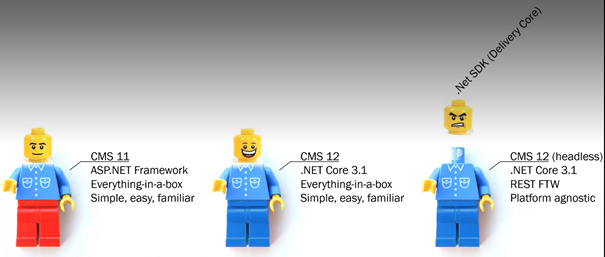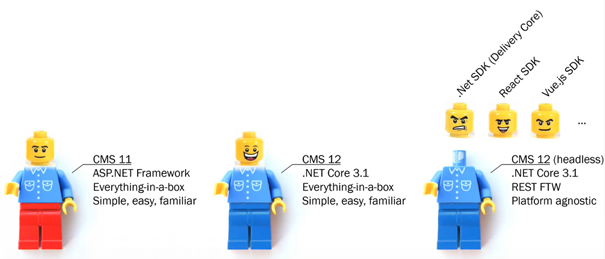Note:
This documentation is archived because it was the preview version of the release of CMS 12/Commerce 14/Search & Navigation 14. See Get started developing with CMS. CMS 11 is built on ASP.NET 4. It is an "everything-in-a-box" type of product, and it is simple, easy to use, and familiar to users. CMS 12 is built on .NET 5, which has a lot of differences from ASP.NET 4, but fundamentally it is still the same product - everything-in-a-box, simple, easy to use, and familiar.

Apart from the underlying framework where the APIs were migrated from ASP .NET 4 to .NET 5, CMS 12 and CMS 11 have a one-to-one behavior and syntax by using the same architectural patterns. You can still build everything in one application as a developer. Nothing changes in how your website looks, how it is structured, or how the editors work.
Why upgrade from ASP .NET to .NET 5?
- Microsoft is no longer investing in the ASP.NET 4 stack.
- .NET 5 performance is impressively fast compared to ASP.NET 4.
- Ecosystem - ASP.NET is a popular framework for server-side programming, APIs, and integrations. Partners want this and with CMS 12 and Commerce 14, they are getting it.
Headless
CMS 12 supports more headless-style deployments.
REST APIs were built because some developers do not want to work with ASP.NET development. For example, JavaScript developers may want to build things in JavaScript frameworks, such as React. Or maybe, they are running their websites on Node JS and do not benefit from using the ASP.NET framework.
REST APIs assume that the logic and control is handled outside of Optimizely. Using the Optimizely headless solutions, you can build solutions regardless of your chosen the framework–you can use either ASP.NET 5 or JavaScript frameworks.

Versions of CMS 12
CMS 12 comes in the following versions:
- CMS 12. The core platform built on .NET 5.
- CMS 12 REST APIs. The headless solution where you can use .NET 5 or JavaScript frameworks. Planned supporting APIs are:
- ASP.NET SDK for headless implementations.
- React SDK for implementations using React.
- Vue.js SDK for implementations using Vue.js.

Last updated: Jul 02, 2021
